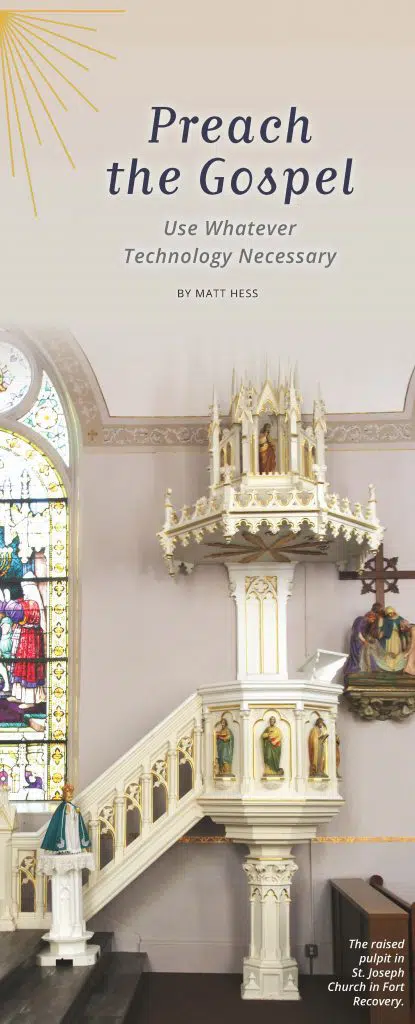Preach the Gospel
 In the Great Commission, Jesus tells His disciples, “Go into all the world and preach the Gospel to all creation” (Mk. 15:16). But what good is it to preach, if the Word is never heard?
In the Great Commission, Jesus tells His disciples, “Go into all the world and preach the Gospel to all creation” (Mk. 15:16). But what good is it to preach, if the Word is never heard?
Before the advent of the microphone, churches sought to use the technology at hand to amplify the Word of God. Pulpits were constructed to help amplify the voice of the person reading or giving the homily. Much like the confessional and baptistry, designating a furnishing in the church building specifically for the Liturgy of the Word also helps congregants recognize its importance.
BEFORE MICROPHONES
The English word pulpit takes its root from the Latin pulpitum, meaning platform. Today, the connection between the simple, yet noble, ambo in the sanctuary and a platform may not be all that obvious. However, before microphones, priests ascended large, raised pulpits with their own staircases to address their congregations.
Standing atop the raised pulpit, the priest was easier to see for the faithful and his voice was projected over the congregation rather than into or through it. Some pulpits were placed on the side of pillars in the nave of the church to further amplify the sound. Many had a canopy over the pulpit, which served as a sounding board, allowing the sound to reverberate off of it.
Sound was also manipulated during the rest of Mass in the sanctuary. Acoustics in traditionally-designed churches tended to run on an axis from the altar, down the main aisle, to the choir loft. Height and the hardness of surfaces in the church allowed the sound to amplify. Depending on the reverberation time and other factors, the congregation could better hear what was happening. These acoustical factors are at play in churches even today, with speaker systems and organ pipes angled and tuned with this in mind. If you are ever alone in a church, it can be fun to play with this simple architectural sound technology and find the best spots in the sanctuary to amplify your voice.
PULPITS TODAY
Today, with modern technology, the height of the pulpit and its sounding board are unnecessary. As a result, there are just a few raised pulpits left in our archdiocese, and even fewer have canopies. Although these marvels of carved wood and marble are, in some churches, still in use, many became casualties of modern technology and were removed decades ago.
When microphones were introduced, the priest could remain both in the sanctuary and on the floor while his congregation could still loudly and clearly hear him. The large, often beautifully-adorned pulpits, were often removed in the 1950s to make way for more seating or better sight lines.
The technology for amplifying sound during the Mass continues to change to fit the needs of our current times. The cordless microphone, lapel mic and, recently, the ear-set microphone, continue to give pastors options for what works best in their liturgical space.
Recently, as parishes streamed Mass online, sound systems of various churches were updated to allow their streaming technology to connect directly into the church’s sound system.
Just as it was for centuries with raised pulpits, the goal today remains the same: to clearly amplify sound to transmit the Gospel in response to Christ’s Great Commission.
This article appeared in the August 2021 edition of The Catholic Telegraph Magazine. For your complimentary subscription, click here.













